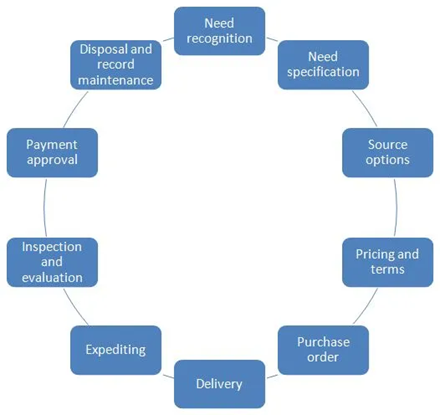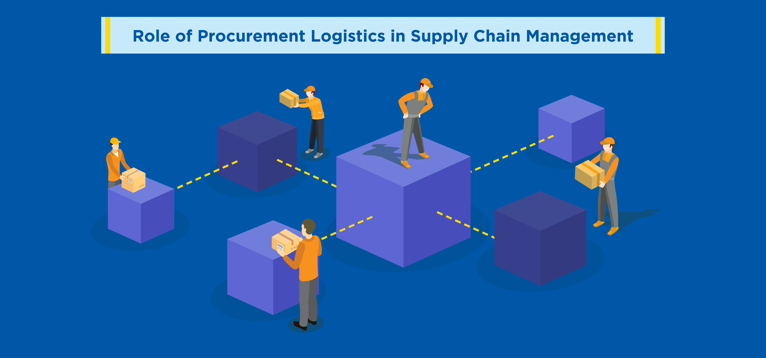Everybody talks about competitive delivery and optimised inventory management.
But all the efforts start from procurement.
Because if you don’t save costs and speed up the supply chain process right from sourcing, the rest of the processes likely face repercussions.
As a result, it’s essential to understand the role of procurement in the supply chain.
Read on to know what is procurement logistics and what are its primary functions in logistics management.
What is Procurement Logistics?
Procurement logistics is the process of supplying raw materials, or even finished goods to either a warehouse, logistics centre, or production facility for the purpose of carrying out the next activity (production, distribution, or sales).
Understand that the definition of procurement logistics will vary depending on whether you’re a manufacturing company or a business enterprise. For a production company, procurement logistics is sourcing the raw materials and for a business unit, it would mean sourcing the finished that are ready to be sold.
Functions of Procurement Logistics
The procurement functions differ from company to company depending on the companies but the logistics flow remains more or less the same.
1. Needs Analysis
It’s ideal to practice sustainability from the sourcing stage itself. This function checks what resources the company requires for a specific amount of time and how many materials and supplies are needed to carry out the manufacturing process or sales. It gives you visibility into your spending areas and finds cost-cutting opportunities.
2. Purchasing
This is the physical transfer of goods from the seller to the buyer after you create a purchase order and release it. Purchasing is where companies take into account the lead time which is the time it takes from when a purchase order is created until the goods are delivered to the customer.
Purchasing involves obtaining appropriate quantities of the resources and services at the lowest cost and choosing a supplier that is reputed for their quality products and prompt deliveries.
3. Receipt and Storage
Once the supplier receives the purchase order, they send the invoice with the price. The procurement team crosschecks the order and ensures the quality and quantity. The payment is issued spending on the conditions agreed upon by both parties.
Once you source the resources, they arrive at the docking area. This is the function where you house the goods and materials on the racks until they are needed for production or sales.
4. Maintain Inventory Records
The buyer and seller both need to maintain procurement records. It’s critical for auditing and taxing purposes in the future. Procurement logistics need to be reviewed regularly to enhance and resolve any conflicts that may arise in the future. It also is the stepping stone towards efficient stock management.

Risks of Inefficient Procurement Logistics
1. Shortage of Stock
Procurement logistics is a component that needs to be in sync with the rest of the logistics functions. If that isn’t the case, you end up having trouble with ordering the right amount of goods and ordering goods fast enough to meet demands. It can increase the risk of backorders, stockouts, lost sales, resource wastage, and high costs.
2. Limited Supply Chain Visibility
Modern logistics management is all about interconnectivity and collaboration between different departments. If you want to create a resilient supply chain, it has to start with the procurement process. A limited supply chain visibility at the initial process results in missed opportunities.
For example, a lack of insight into lead time messes up the reordering schedules. Or lack of communication about delays in the procurement process disables the entire supply chain to efficiently respond to delays and keep the supply chain running.
The entire chain can disrupt if there are information silos at the procurement level. Addressing them allows the rest of the department to be involved with the procurement process and prepare for any hardships beforehand.
Tips to Improve Procurement Logistics
1. Leverage Demand Forecasting
One of the biggest functions of procurement logistics is to know how many materials or goods you want to source from the supplier. If you want to achieve accuracy in this process, demand forecasting is your best bet to optimise inventory levels and meet customer demands.
Demand forecasting considers previous data and predictive analysis to provide an accurate estimate of future demand, units to reorder, how many units to order, and so on. This reduces the risks associated with too much or too little inventory.
2. Calculate Procurement Lead Times
Lead time takes into account multiple factors like what the product is, from where it is arriving, how it is arriving, how long it takes to produce, etc.
Since you want to avoid any miscalculations, it’s advisable to use an inventory management system that has the ability to automate setting up for reorder points. You just need to add the estimated lead times and forecasting data.
3. Track Raw Materials in Inventory Management System
Yes, tracking finished goods is important. Especially if you want to meet unrealistic delivery expectations. But the same way, raw materials require equal attention when it comes to inventory tracking since they play a significant role in how you produce and deliver goods.
Tracking raw materials in the inventory management system gives you a comprehensive overview of all inventory levels under a single window. It prompts you to take action in case you’re running low on certain materials so that there’s no roadblock in the production and order fulfilment process.
4. Optimise Procurement Logistics
When you talk about optimising the supply chain, you need to individually optimise every single function within it. Some ways you can optimise your procurement logistics is:
- Finding an affordable supplier
- Choosing suppliers that are closer to the delivery destination
- Choosing shorter routes
- Diversifying your supplier network
Wrapping Up
Procurement logistics set the trail right for the rest of the supply chain. If you want assistance in managing your procurement, you can contact us at PACK & SEND. We offer a comprehensive range of logistics solutions and take over the hassles of your logistics so you can focus on other strategic areas of your business.
Image source: Project Guru
